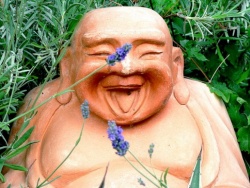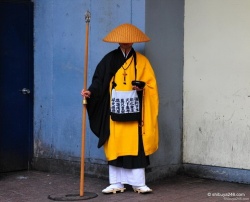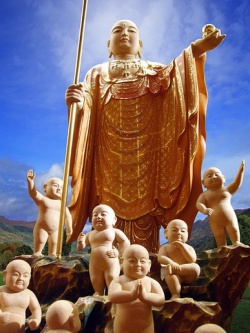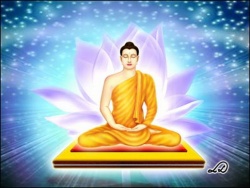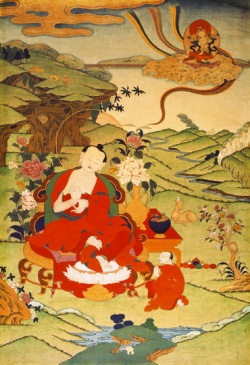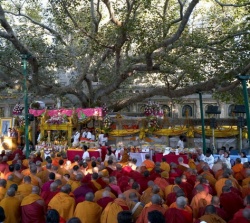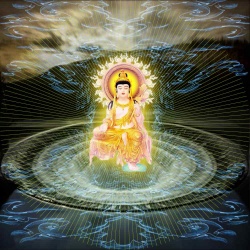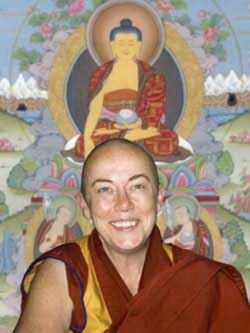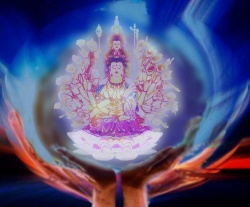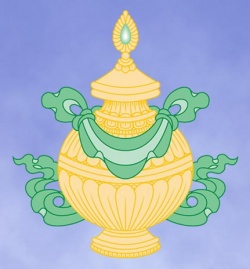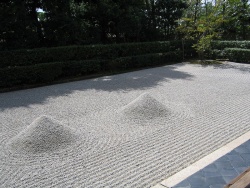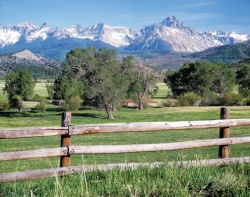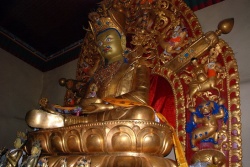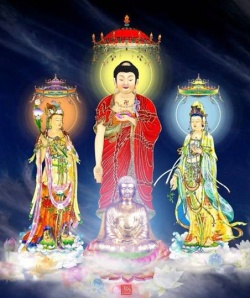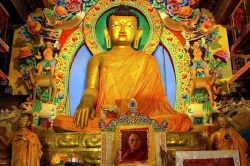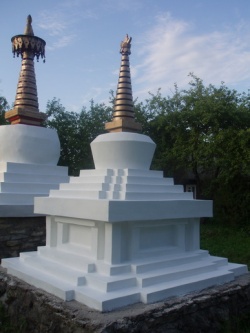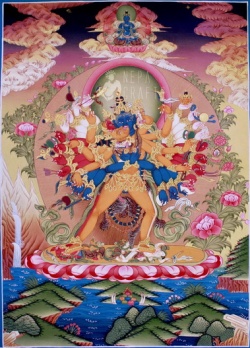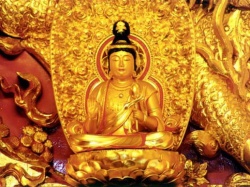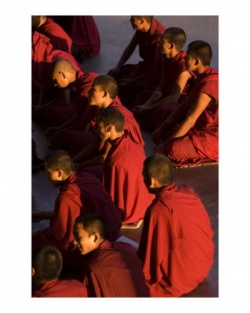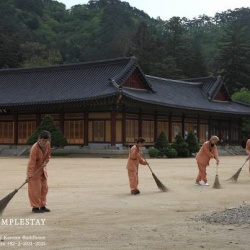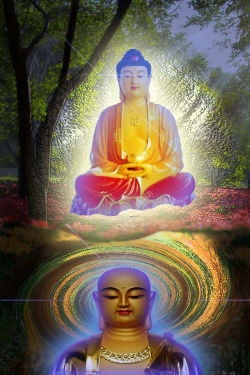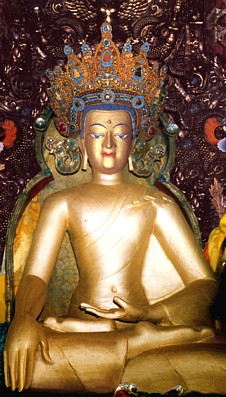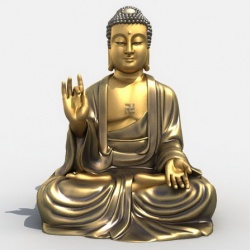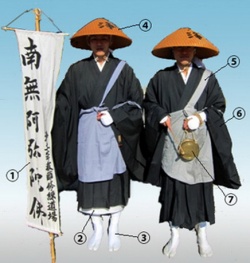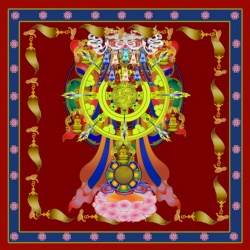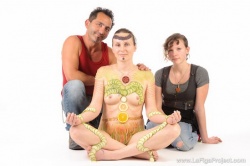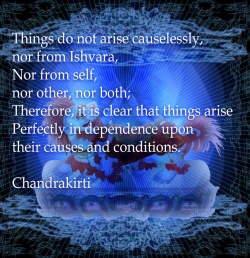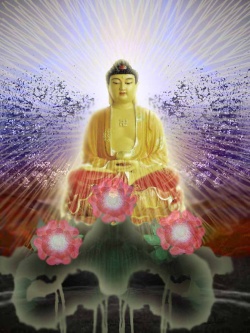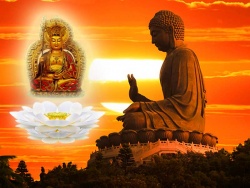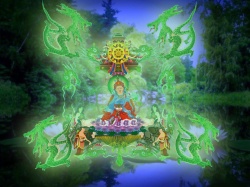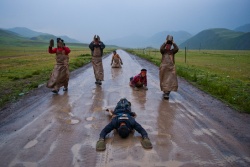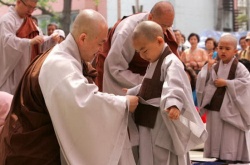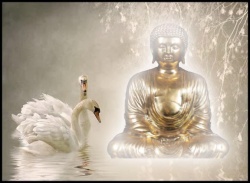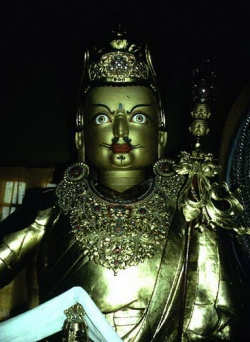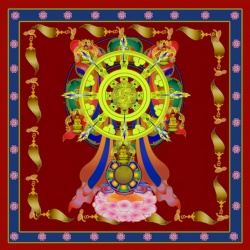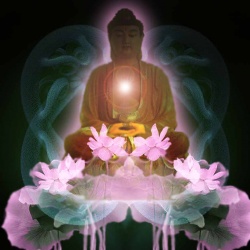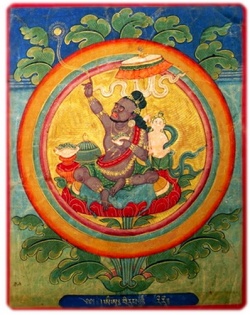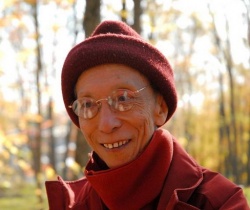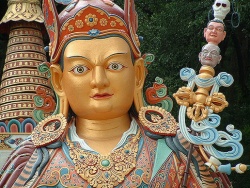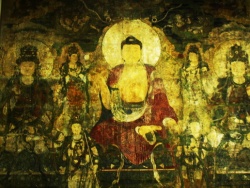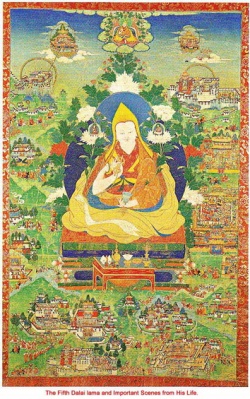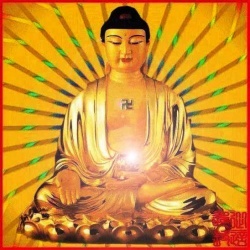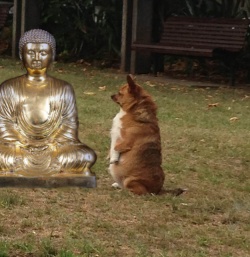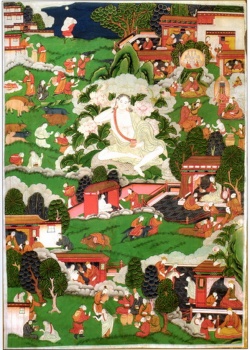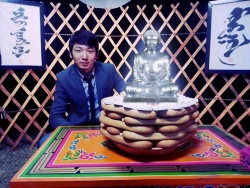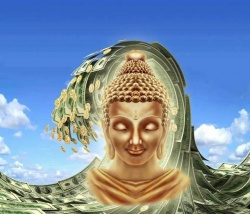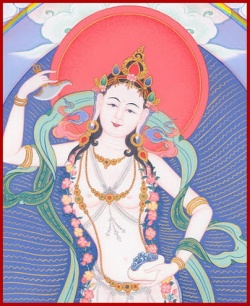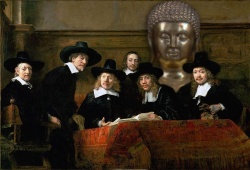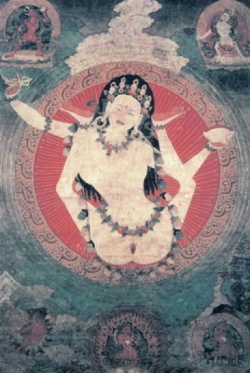Samyutta Nikaya The - Grouped Discourses
The Samyutta Nikaya, the third division of the Sutta Pitaka, contains 2,889 suttas grouped into five sections (vaggas).
Each vagga is further divided into samyuttas, each of which in turn contains a group of suttas on related topics.
The samyuttas are named according to the topics of the suttas they contain.
For example, the Kosala Samyutta (in the Sagatha Vagga) contains suttas concerning King Pasenadi of Kosala; the Vedana Samyutta (in the Salayatana Vagga) contains suttas concerning feeling (vedana); and so on.
An excellent modern print translation of the complete Samyutta Nikaya is Bhikkhu Bodhi's The Connected Discourses of the Buddha: A New Translation of the Samyutta Nikaya (Boston: Wisdom Publications, 2000; originally published in two volumes, but now available in a single volume).
A fine anthology of selected suttas is Handful of Leaves (Vol. 2), by Thanissaro Bhikkhu (distributed by the Metta Forest Monastery).
The suttas are numbered here by samyutta (chapter) and sutta, with the suttas numbered sequentially from the start of each samyutta, using as a guide the Rhys Davis & Woodward PTS English translations of the Samyutta Nikaya (The Book of the Kindred Sayings).
The braces {} that follow each sutta and samyutta title contain the corresponding volume and starting page number, first in the PTS romanized Pali edition of the Samyutta Nikaya, then in Bhikkhu Bodhi's Connected Discourses of the Buddha ("CDB"). The translator appears in the square brackets [].
See also this handy table for converting between traditional (DPR, CSCD) and modern (ATI, CDB) samyutta numbering systems. Contents
Sagatha-vagga — The Section of Verses (contains samyuttas 1-11)
Nidana-vagga — The Section on Causation (12-21)
Khandha-vagga — The Section on the Aggregates (22-34)
Salayatana-vagga — The Section on the Six Sense Bases (35-44)
Maha-vagga — The Great Section (45-56)
Sagatha Vagga — The Section of Verses
Devata-samyutta — Devas
SN 1.1: Ogha-tarana Sutta — Crossing over the Flood {S i 1; CDB i 89} Thanissaro. The Buddha explains how he "crossed over the flood" of craving.
SN 1.3: Upaneyya.m Sutta — Doomed {S i 2; CDB i 90} Walshe.
SN 1.9: Maanakaamo Sutta — Vain Conceits {S i 4; CDB i 93} Walshe.
SN 1.10: Arañña Sutta — The Wilderness/A Face So Calm {S i 4; CDB i 93} Ireland | Olendzki | Thanissaro. Why do monks living in the forest wilderness look so happy?
SN 1.17: Dukkara.m (Kummo) Sutta — Difficult {S i 7; CDB i 96} Walshe.
SN 1.18: Hiri Sutta — Conscience {S i 7; CDB i 96} Thanissaro. A lovely short teaching on the rarity and value of conscientiousness.
SN 1.20: Samiddhi Sutta — About Samiddhi/Samiddhi {S i 8; CDB i 97} [[Thanissaro] | Walshe. A devata wonders: why waste time meditating in the hopes of some future reward, when one can enjoy sensual pleasures right here and now?
SN 1.25: Araha.m Sutta — The Arahant {S i 14; CDB i 102} Walshe.
SN 1.38: Sakalika Sutta — The Stone Sliver {S i 27; CDB i 116} Thanissaro. After an attempt on his life, the Buddha shows by example how to handle pain.
SN 1.41: Aditta Sutta — (The House) On Fire {S i 31; CDB i 119} Thanissaro. A deva visits the Buddha and recites a lovely verse on the urgency of giving.
SN 1.42: Kindada Sutta — A Giver of What {S i 32; CDB i 120} Thanissaro. The Buddha explains to a deva the true value of various kinds of gifts.
SN 1.69: Iccha Sutta — Desire {S i 40; CDB i 132} Thanissaro. A brief and elegant summary of the heart of the Buddha's teaching.
SN 1.71: Ghatva Sutta — Having Killed {S i 41; CDB i 133} Thanissaro. The Buddha describes one thing that deserves to be killed.
Devaputta-samyutta — Sons of the Devas
SN 2.6: Kamada Sutta — Kamada's Lament {S i 48; CDB i 142} [Olendzki]. The Buddha reassures a doubting deva that, though the journey to Awakening may indeed be long and hard, it really can be done.
SN 2.7: Pañcalacanda Sutta — Pañcalacanda the Deva's Son {S i 48; CDB i 142} Thanissaro. Finding an opening to Nibbana.
SN 2.8: Taayano Sutta — Taayana {S i 49; CDB i 143} Walshe.
SN 2.9: Candima Sutta — The Moon Deity's Prayer for Protection {S i 50; CDB i 144} Piyadassi. The Buddha intervenes on behalf of a deva caught in the grips of an evil demon. This sutta belongs to the group of paritta (protection) suttas that are chanted by monastics for devotional and ceremonial purposes.
SN 2.10: Suriya Sutta — The Sun Deity's Prayer for Protection {S i 51; CDB i 145} Piyadassi. The Buddha intervenes on behalf of a deva caught in the grips of an evil demon. This sutta belongs to the group of paritta (protection) suttas that are chanted by monastics for devotional and ceremonial purposes.
SN 2.19: Uttara Sutta — Uttara the Deva's Son {S i 54; CDB i 150} Thanissaro. Doing good and making merit: are these the best one can aim for in this short life?
SN 2.25: Jantu Sutta — Jantu {S i 61; CDB i 156} Walshe.
SN 2.26: Rohitassa Sutta — To Rohitassa {S i 61; CDB i 157} Thanissaro. A well-traveled deva learns that we don't have to go to the ends of the world to find an end to suffering; we need look no further than right here, in this very body.
Kosala-samyutta — King Pasenadi of Kosala
SN 3.1: Dahara Sutta — Young {S i 68; CDB i 164} Thanissaro. The Buddha reminds King Pasenadi that one's age is no measure of one's wisdom.
SN 3.4: Piya Sutta — Dear {S i 71; CDB i 167} Thanissaro. If you truly care about your own and others' welfare, then choose your actions with care.
SN 3.5: Atta-rakkhita Sutta — Self-protected {S i 72; CDB i 169} Thanissaro. The Buddha's defense policy. [TB]
SN 3.6: Appaka Sutta — Few {S i 73; CDB i 168} Thanissaro. The Buddha reminds King Pasenadi of the pitfalls of wealth and luxury.
SN 3.7: Atthakarana Sutta — In Judgment {S i 74; CDB i 170} Thanissaro. King Pasenadi discovers what motivates people to tell lies.
SN 3.8: Mallikaa Sutta — Mallikaa {S i 75; CDB i 170} Walshe.
SN 3.13: Donapaka Sutta/Do.napaaka Sutta — King Pasenadi Goes on a Diet/A Heavy Meal {S i 81; CDB i 176} [Olendzki | Walshe. How King Pasenadi learns to use mindfulness to control his overeating
SN 3.14: Sangama Sutta — A Battle (1) {S i 82; CDB i 177} Thanissaro.
SN 3.15: Sangama Sutta — A Battle (2) {S i 84; CDB i 178} Thanissaro. Two stories about the battles fought between rival kings, poignantly demonstrating how in war there is security neither for the victor nor the vanquished.
SN 3.17: Appamada Sutta — Heedfulness {S i 86; CDB i 179} Thanissaro. The Buddha reveals the one quality in the heart that offers real security.
SN 3.19: Aputtaka Sutta — Heirless (1) {S i 89; CDB i 182} Thanissaro. The Buddha advises a rich householder on the proper use and enjoyment of wealth.
SN 3.20: Aputtaka Sutta — Heirless (2) {S i 92; CDB i 183} Thanissaro. Give generously and without regret, or you may suffer the same sad consequences as this wealthy householder.
SN 3.23: Loka Sutta — (Qualities of) the World {S i 98; CDB i 189} Thanissaro. Three common things in the world that inevitably lead to harm and suffering.
SN 3.24: Issattha Sutta — Archery Skills {S i 98; CDB i 190} Thanissaro. Generosity yields good results. But to whom should we give to reap the very best results?
[SuttaReadings.net icon] SN 3.25: Pabbatopama Sutta — Irresistible Force/The Simile of the Mountains {S i 100; CDB i 192} [Olendzki | Thanissaro. The Buddha offers a powerful simile to King Pasenadi to underscore the imminence of death and the urgency of Dhamma practice.
Mara-samyutta — Mara
Stories of Mara's attempts to outwit the Buddha.
SN 4.8: Nandana Sutta — Delight {S i 107; CDB i 200} Thanissaro. Mara and the Buddha debate this question: Are possessions a source of joy or of grief?
SN 4.13: Sakalika Sutta — The Stone Sliver {S i 110; CDB i 203} Thanissaro. The Buddha, recuperating from an assassination attempt, receives an unwelcome visit from Mara.
SN 4.19: Kassaka Sutta — The Farmer {S i 114; CDB i 208} Thanissaro. Mara proclaims his dominion over the sensory world, but the Buddha explains that he (Buddha) dwells in the one place that Mara can never go.
SN 4.20: Rajja Sutta — Rulership {S i 116; CDB i 209} Thanissaro. Mara, seeing that the Buddha has developed the four bases of power (iddhipada), tries to persuade him to give up the monastic life and become a powerful world ruler.
Bhikkhuni-samyutta — Nuns
Stories of Mara's attempts to lure the nuns away from their meditation spots in the forest by asking them provocative questions. Without exception, these wise women conquer Mara decisively.
SN 5.1: Alavika Sutta — Alavika/Sister Alavika {S i 128; CDB i 221} Bodhi | [Thanissaro]]. Mara: Why bother meditating? Why not just relax and enjoy life's pleasures?
SN 5.2: Soma Sutta — Soma/Mara Meets His Match/Sister Soma {S i 129; CDB i 222} Bodhi | Olendzki | Thanissaro. Can women achieve Awakening? Ven. Sister Soma handles this misguided question with ease.
SN 5.3: Gotami Sutta — Gotami/Sister Gotami {S i 129; CDB i 223} Bodhi | Thanissaro. Mara: Why bother sitting in solitude in the forest?
SN 5.4: Vijaya Sutta — Vijaya/Sister Vijaya {S i 130; CDB i 224} Bodhi | Thanissaro. Mara: Why don't we just put aside the meditation for awhile and go out dancing?
SN 5.5: Uppalavanna Sutta — Uppalavanna/Sister Uppalavanna {S i 131; CDB i 225} Bodhi | Thanissaro. Mara: Why don't you just give up the dangers of the forest and live somewhere safer?
SN 5.6: Cala Sutta — Cala/Sister Cala {S i 132; CDB i 226} Bodhi | Thanissaro. Mara: What's wrong with being reborn, anyway?
SN 5.7: Upacala Sutta — Upacala/Sister Upacala {S i 133; CDB i 227} Bodhi | Thanissaro. Mara: Why not just settle for a happy rebirth among the devas?
SN 5.8: Sisupacala Sutta — Sisupacala/Sister Sisupacala {S i 133; CDB i 227} Bodhi | Thanissaro. Sister Sisupacala shows Mara how following the path of Dhamma doesn't mean buying into to a fixed philosophy.
SN 5.9: Sela Sutta — Sela/Sister Sela {S i 134; CDB i 228} Bodhi | Thanissaro. Mara tries to trip up Ven. Sister Sela with metaphysical questions.
SN 5.10: Vajira Sutta — Vajira/Sister Vajira {S i 134; CDB i 229} Bodhi | Thanissaro. Have you ever found yourself getting lured out of meditation by some fascinating, but utterly speculative, train of thought? Ven. Sister Vajira shows how to deal with this.
Brahma-samyutta — Brahma deities
SN 6.1: Ayacana Sutta — The Request {S i 136; CDB i 231} Thanissaro. Immediately after his Awakening, the Buddha receives a visit from Brahma Sahampati, who pleads with the Buddha to teach the Dhamma, for the sake of those "with little dust in their eyes."
SN 6.2: Garava Sutta — Reverence {S i 138; CDB i 233} Thanissaro. Shortly after his Awakening, the Buddha reviews the world around him, searching for another being whom he can now rightly call his teacher.
SN 6.13: Andhakavinda Sutta — Let the Wilderness Serve! {S i 154; CDB i 248} [Olendzki]. Brahma Sahampati offers up verses of praise for the Buddha, who sits meditating alone in the wilderness.
SN 6.15: Parinibbana Sutta — Total Unbinding {S i 157; CDB i 251} Thanissaro. Four eyewitness accounts of the passing away of the Buddha.
Brahmana-samyutta — Brahmans
SN 7.1: Dhanañjaanii Sutta — Dhanañjaani {S i 160; CDB i 254} Walshe.
SN 7.2: Akkosa Sutta/Akkoso Sutta — Insult/Abuse {S i 161; CDB i 255} Buddharakkhita | Thanissaro | Walshe. What is your best response when someone is angry with you? Hint: if you offer some food to a guest, but the guest declines the offer, to whom does the food belong?
SN 7.6: Jata Sutta — The Tangle {S i 165; CDB i 259} Thanissaro. The Buddha answers Jata Bharadvaja's famous question, "Who can untangle this tangle of craving?"
SN 7.11: Kasi Bharadvaja Sutta — Discourse to Bharadvaja, the Farmer/To the Plowing Bharadvaja {S i 171; CDB i 266} Piyadassi | Thanissaro. The Buddha answers a farmer who asserts that monks do no useful work, and thus don't deserve to eat.
SN 7.12: Udaya Sutta — Breaking the Cycle {S i 173; CDB i 268} [Olendzki]. In delightfully alliterative Pali verse, the Buddha tells how, without true wisdom, the cycle of death and re-becoming are doomed to drone on and on and on.
SN 7.14: Maha-sala Sutta — Very Rich {S i 175; CDB i 271} Thanissaro. A touching glimpse into the sorrow that a father feels when his ungrateful children fail to honor him in his old age. Treat your parents well.
SN 7.17: Navakammika Sutta — The Builder {S i 179; CDB i 274} Thanissaro. What useful work can one possibly accomplish by sitting in meditation under a tree in the forest?
SN 7.18: Katthaharaka Sutta — Buddha in the Forest/Firewood-gathering {S i 180; CDB i 275} [Olendzki | Thanissaro. How does the Buddha practice jhana in the forest? [TB]
SN 7.21: Sangaarava Sutta — Sangaarava {S i 182; CDB i 278} Walshe.
Vangisa-samyutta — Ven. Vangisa
SN 8.4: Ananda Sutta — Ananda {S i 188; CDB i 283} Thanissaro. Ven. Ananda offers advice to Ven. Vangisa on how to subdue lust.
Vana-samyutta — The forest
SN 9.1: Viveka Sutta — Seclusion {S i 197; CDB i 294} Thanissaro. A deva comes to the aid of a forest monk whose mind had been wandering during meditation.
SN 9.6: Anuruddha Sutta — Anuruddha {S i 200; CDB i 297} Thanissaro. One of Ven. Anuruddha's consorts from a previous life as a deva, visits him and invites him back.
SN 9.9: Vajjiputta Sutta — The Vajjian Princeling {S i 201; CDB i 300} Thanissaro. If you've ever wondered, "Why bother meditate?", listen to this devata's advice.
SN 9.11: Ayoniso-manasikara Sutta — Inappropriate Attention {S i 203; CDB i 301} Thanissaro. Food for thought for a monk being gnawed away by his thoughts.
SN 9.14: Gandhatthena Sutta — Stealing the Scent/The Thief of a Scent {S i 204; CDB i 303} [Olendzki | Thanissaro. Have you ever wished for a guardian angel to warn you before you do something foolish? Here's one with an important lesson.
Yakkha-samyutta — Yakkha demons
SN 10.8: Sudatta Sutta — About Sudatta (Anathapindika) {S i 210; CDB i 311} Thanissaro. Anathapindika, the wealthy benefactor who would later donate the famous Jeta's Grove monastery to the Sangha, meets the Buddha for the first time.
SN 10.12: Alavaka Sutta — Discourse to Alavaka/To the Alavaka Yakkha {S i 213; CDB i 314} Piyadassi | Thanissaro. A yakkha challenges the Buddha with riddles and threatens to beat him up.
Sakka-samyutta — Sakka (the Deva king)
SN 11.3: Dhajagga Sutta — Banner Protection/The Top of the Standard {S i 218; CDB i 319} Piyadassi | Thanissaro. Are you ever overcome by fear? The Buddha offers an antidote.
SN 11.4: Vepacitti Sutta — Calm in the Face of Anger {S i 220; CDB i 321} [Olendzki]. Sakka, king of the devas, explains to a skeptic how forbearance is the best response to another's anger.
SN 11.5: Subhasita-jaya Sutta — Victory Through What is Well Spoken {S i 222; CDB i 323} Thanissaro. Marvelous account of a debating contest between two deities concerning the best way to respond to an angry person.
Nidana Vagga — The Section on Causation Samyutta:
Nidana-samyutta — Paticcasamuppada (dependent co-arising)
SN 12.2: Paticca-samuppada-vibhanga Sutta — Analysis of Dependent Co-arising {S ii 2; CDB i 534} Thanissaro. A summary of the causal chain of dependent co-arising.
SN 12.10: Mahaa Sakyamuni Gotamo Sutta — Gotama the Great Sage of the Sakya {S ii 10; CDB i 537} Walshe.
SN 12.11: Ahara Sutta — Nutriment {S ii 11; CDB i 540} Nyanaponika | Thanissaro. The Buddha explains how the teachings on the four nutriments (ahara) fits in with dependent co-arising.
SN 12.12: Phagguna Sutta — To Phagguna {S ii 13; CDB i 541} Nyanaponika | Thanissaro Questions that presuppose the existence of an abiding "self," are fundamentally invalid. The Buddha shows how to re-frame these questions in a way that conduces to liberation.
SN 12.15: Kaccayanagotta Sutta/Kaccaayanagotto Sutta — To Kaccayana Gotta (on Right View)/Kaccaayana {S ii 16; CDB i 544} Thanissaro | Walshe. The Buddha explains to Ven. Kaccayana Gotta how dependent co-arising applies in the development of right view.
SN 12.16: Dhammakathiko Sutta — The Teacher of the Dhamma {S ii 18; CDB i 545} Walshe.
SN 12.17: Acela Sutta — To the Clothless Ascetic/Naked Kassapa {S ii 18; CDB i 545} Thanissaro]] | Walshe (excerpt)]. A perplexed ascetic asks the Buddha: "Is dukkha created by the self? By other? By both? By neither?" The Buddha's answers at first baffle, then inspire, Kassapa, who eventually gains Awakening.
SN 12.19: Bala-pandita Sutta — The Fool & the Wise Person {S ii 23; CDB i 549} Thanissaro. What is the difference between a fool and a wise person?
SN 12.20: Paccaya Sutta — Requisite Conditions {S ii 25; CDB i 550} Thanissaro. The Buddha explains that when dependent co-arising is clearly seen and understood, wrong views and confusion disappear.
SN 12.22: Dasabalaa (2) Sutta — Ten Powers {S ii 28; CDB i 553} Walshe (excerpt).
SN 12.23: Upanisa Sutta/Upanisaa Sutta — Discourse on Supporting Conditions/Prerequisites/Upanisaa {S ii 29; CDB i 553} Bodhi | Thanissaro | Walshe (excerpt)]. The Buddha explains how seeing deeply into dependent co-arising leads to Awakening. The causal chain here includes an additional set of factors not present in the "standard" chain of dependent co-arising.
SN 12.25: Bhumija Sutta — To Bhumija {S ii 37; CDB i 559} Thanissaro. What is the origin of pleasure and pain? Ven. Sariputta clears up some misconceptions.
SN 12.31: Bhutamidam Sutta — This Has Come Into Being {S ii 47; CDB i 566} Thanissaro | Nyanaponika (excerpt). What characterizes the difference between a run-of-the-mill person, one who practices the Dhamma, and one who has fully realized the Dhamma?
SN 12.35: Avijjapaccaya Sutta — From Ignorance as a Requisite Condition {S ii 60; CDB i 573} Thanissaro. Is there someone or something that lies behind the processes described in dependent co-arising?
SN 12.38: Cetana Sutta/Cetanaa Sutta — Intention/Volition {S ii 65; CDB i 576} Thanissaro | Walshe. The Buddha explains the causal link between mental fabrications and consciousness.
SN 12.44: Loka Sutta — The World {S ii 73; CDB i 581} Thanissaro. How the world arises and falls according to the law of dependent co-arising.
SN 12.46: Aññatra Sutta — A Certain Brahman {S ii 75; CDB i 583} Thanissaro. A brahman wonders: When I perform an action (kamma), am I the same person when I experience its results, or am I a different person? The Buddha helps to clear up this man's confused thinking.
SN 12.48: Lokayatika Sutta — The Cosmologist {S ii 77; CDB i 584} Thanissaro. The Oneness of all being is sometimes taught as a basic Buddhist principle, but this discourse shows that the Buddha himself rejected the idea. It is simply one of the extremes that he avoided by teaching dependent co-arising.
SN 12.52: Upadana Sutta — Clinging {S ii 84; CDB i 589} Thanissaro. The Buddha uses a marvelous fire simile to describe the nature of clinging.
SN 12.60: Nidaana.m Sutta — Aananda's Mistake {S ii 92; CDB i 593} Walshe (excerpt).
SN 12.61: Assutavā Sutta — The Spiritually-Unlearned (1)/Uninstructed (1) {S ii 94; CDB i 595} [Nizamis | Thanissaro. With a striking simile, the Buddha points out the folly of believing this fickle mind to be "self."
SN 12.63: Puttamansa Sutta — A Son's Flesh {S ii 97; CDB i 597} Nyanaponika | Thanissaro. A meditation on inter-relatedness, showing with four striking similes the suffering inherent in everything the body and mind depend upon for nourishment. [TB]
SN 12.64: Atthi Raga Sutta — Where There is Passion {S ii 101; CDB i 599} Nyanaponika | Thanissaro. The Buddha describes four factors to which the mind habitually clings. Those who succeed in abandoning passion for these "nutriments" can realize the cessation of birth, aging, and death.
[SuttaReadings.net icon] SN 12.65: Nagara Sutta — The City {S ii 104; CDB i 601} Thanissaro. The Buddha retells the story of how, on the eve of his Awakening, he re-discovered the long-forgotten laws of dependent co-arising and the Four Noble Truths.
SN 12.67: Nalakalapiyo Sutta — Sheaves of Reeds {S ii 112; CDB i 607} Thanissaro. In a discussion about dependent co-arising with Ven. Maha Kotthita, Ven. Sariputta invokes a helpful simile to illustrate the relationship between consciousness and name-and-form.
SN 12.68: Kosambi Sutta — At Kosambi (On Knowing Dependent Co-arising) {S ii 115; CDB i 609} Thanissaro. Four good friends share a frank discussion about their grasp of dependent co-arising. One uses a memorable simile to describe the difference between stream-entry and arahatship.
SN 12.70: Susima Sutta — About Susima {S ii 119; CDB i 612} Thanissaro. The Buddha explains to Susima that development of psychic powers is not a prerequisite for enlightenment.
Abhisamaya-samyutta — Realization
SN 13.1: Nakhasikha Sutta — The Tip of the Fingernail {S ii 133; CDB i 621} Thanissaro.
SN 13.2: Pokkharani Sutta — The Pond {S ii 133; CDB i 621} Thanissaro.
SN 13.8: Samudda Sutta — The Ocean {S ii 137; CDB i 624} Thanissaro. These three suttas offer vivid similes that give a sense of how much suffering one totally puts behind oneself upon attaining the stream to Nibbana. Good encouragement for putting some extra effort into the practice.
Dhatu-samyutta — Elements
SN 14.11: Sattadhatu Sutta — Seven Properties {S ii 150; CDB i 634} Thanissaro. An alternative way of looking at the stages of concentration practice
Anamatagga-samyutta — The unimaginable beginnings of samsara
SN 15.3: Assu Sutta — Tears {S ii 179; CDB i 652} Thanissaro. "Which is greater, the tears you have shed while transmigrating and wandering this long, long time... or the water in the four great oceans?"
SN 15.9: Danda Sutta — The Stick {S ii 184; CDB i 656} Thanissaro. We bounce from one birth to the next, as a thrown stick bounces along the ground.
SN 15.11: Duggata Sutta — Fallen on Hard Times {S ii 186; CDB i 657} Thanissaro. When you encounter an unfortunate person, remember: you've been there, too.
SN 15.12: Sukhita Sutta — Happy {S ii 186; CDB i 658} Thanissaro. When you encounter a fortunate person, remember: you've been there, too.
SN 15.13: Timsa Sutta — Thirty {S ii 187; CDB i 658} Thanissaro. Which is greater, the blood you have shed in your long journey in samsara, or the water in the four great oceans?
SN 15.14-19: Mata Sutta — Mother {S ii 189; CDB i 659} Thanissaro. It's hard to meet someone who has not been, at some time in the distant past, your mother, father, son, daughter, sister, or brother.
Kassapa-samyutta — Ven. Maha Kassapa
SN 16.1: Santu.t.tha.m Sutta — Contentment {S ii 194; CDB i 662} Walshe.
SN 16.2: Anottaapi Sutta — Carelessness {S ii 195; CDB i 663} Walshe.
SN 16.5: Jinna Sutta — Old {S ii 202; CDB i 666} Thanissaro. Ven. Maha Kassapa explains why he chooses to continue meditating in the forest wilderness even though he has long since attained arahantship.
SN 16.13: Saddhammapatirupaka Sutta/Saddhamma-pa.tiruupaka.m Sutta — A Counterfeit of the True Dhamma/False Dhamma {S ii 223; CDB i 680} Thanissaro | Walshe. The Buddha issues a warning: a society that fails to show respect for these five things contributes to the eventual decline and disappearance of the Dhamma.
Labhasakkara-samyutta — Gains and tribute
SN 17.3: Kumma Sutta — The Turtle {S ii 227; CDB i 683} Thanissaro]]. To seek fame and status: like walking around with a harpoon stuck in your back.
SN 17.5: Pilahaka Sutta/Piḷhika Sutta — The Dung Beetle {S ii 228; CDB i 684} Thanissaro | Walshe. To seek fame and status: like carrying around a ball of dung.
SN 17.8: Sigala Sutta — The Jackal {S ii 230; CDB i 685} Thanissaro. To seek fame and status is like being a mangy jackal.
Rahula-samyutta — Ven. Rahula
Lakkhana-samyutta — Ven. Lakkhana
Opamma-samyutta — Comparisons
SN 20.2: Nakhasikha Sutta — The Tip of the Fingernail {S ii 263; CDB i 706} Thanissaro. The Buddha offers a simile for the preciousness of this human birth.
SN 20.4: Okkha Sutta — Serving Dishes {S ii 264; CDB i 707} Thanissaro.
SN 20.5: Satti Sutta — The Spear {S ii 265; CDB i 707} Thanissaro. Two suttas on the extraordinary power of metta (goodwill).
SN 20.6: Dhanuggaha Sutta — The Archer {S ii 265; CDB i 708} Thanissaro. How quickly life passes! Knowing this, how should we conduct our lives?
SN 20.7: Ani Sutta — The Peg {S ii 266; CDB i 708} Thanissaro. Be careful: there are many popular teachings nowadays that may sound good, but they're not necessarily consistent with the Buddha's teachings.
Bhikkhu-samyutta — Monks
SN 21.1: Kolita Sutta — Kolita {S ii 273; CDB i 713} Thanissaro. The real meaning of noble silence.
SN 21.2: Upatissa Sutta — About Upatissa (Sariputta) {S ii 274; CDB i 714} Thanissaro. Is there anything in the world whose loss would sadden an arahant?
SN 21.6: Lakuntaka Bhaddiya Sutta — About Bhaddiya the Dwarf {S ii 279; CDB i 718} [Nizamis]. One's inner wisdom and outward appearance are unrelated.
SN 21.8: Nando Sutta — Nanda {S ii 281; CDB i 719} Walshe. A primer for monks on what not to wear.
SN 21.10: Theranama Sutta — A Monk by the Name of Elder {S ii 282; CDB i 720} Thanissaro. The Buddha explains to a wandering monk the true meaning of solitude.
Khandha Vagga — The Section on the Aggregates Samyutta:
Khandha-samyutta — The clinging-aggregates
SN 22.1: Nakulapita Sutta — To Nakulapita {S iii 1; CDB i 853} Thanissaro. The Buddha explains to the aging householder Nakulapita how one need not be sick in mind even though one may be sick in body.
SN 22.2: Devadaha Sutta — At Devadaha {S iii 5; CDB i 856} Thanissaro. Ven. Sariputta explains the best way to introduce the Buddha's teachings to inquisitive, intelligent people.
SN 22.3: Haliddakani Sutta — To Haliddakani {S iii 9; CDB i 859} Thanissaro. Ven. Maha Kaccana explains to a householder what it means to live as a monk, free of society, free of sensual passion, free of yearning, and free of quarreling.
SN 22.5: Samadhi Sutta — Concentration {S iii 13; CDB i 863} Thanissaro. How the development of concentration leads to discernment.
SN 22.7: Upaadaaparitassanaa Sutta — Grasping and Worry {S iii 15; CDB i 865} Walshe. The Buddha describes how ideas about the self lead to worry, and how to be free of such worry.
SN 22.22: Bhāra Sutta — The Burden {S iii 25; CDB i 871} [Nizamis | Thanissaro | Walshe. The Buddha describes the burdens we carry, and how to cast them off.
SN 22.23: Pariñña Sutta — Comprehension {S iii 26; CDB i 872} Thanissaro. True comprehension means the end of passion, aversion, and delusion.
SN 22.36: Bhikkhu Sutta — The Monk {S iii 36; CDB i 879} Thanissaro. How we define ourselves in terms of the aggregates, and how we don't have to do so.
SN 22.39: Anudhamma Sutta — In Accordance with the Dhamma (1) {S iii 40; CDB i 882} Thanissaro. Towards the end of his life, the Buddha stated that the proper way to pay homage to him was to "practice the Dhamma in accordance with the Dhamma." This sutta explains what that means, in terms of cultivating disenchantment (nibbida). [TB]
SN 22.40: Anudhamma Sutta — In Accordance with the Dhamma (2) {S iii 41; CDB i 882} Thanissaro. Towards the end of his life, the Buddha stated that the proper way to pay homage to him was to "practice the Dhamma in accordance with the Dhamma." This sutta explains what that means, in terms of focusing on inconstancy (anicca). [TB]
SN 22.41: Anudhamma Sutta — In Accordance with the Dhamma (3) {S iii 41; CDB i 882} Thanissaro. Towards the end of his life, the Buddha stated that the proper way to pay homage to him was to "practice the Dhamma in accordance with the Dhamma." This sutta explains what that means, in terms of focusing on stress/suffering (dukkha). [TB]
SN 22.42: Anudhamma Sutta — In Accordance with the Dhamma (4) {S iii 41; CDB i 882} Thanissaro. Towards the end of his life, the Buddha stated that the proper way to pay homage to him was to "practice the Dhamma in accordance with the Dhamma." This sutta explains what that means, in terms of focusing on not-self (anatta). [TB]
SN 22.43: Attadiipaa Sutta — An Island to Oneself {S iii 42; CDB i 882} Walshe. Presaging the famous words he would utter in his final days, the Buddha elaborates on his advice to "be an island unto yourself."
SN 22.47: Samanupassana Sutta/Samanupassanaa Sutta — Assumptions/Ways of Regarding {S iii 46; CDB i 885} Thanissaro | Walshe. The Buddha speaks on the assumptions that underlie self-view.
SN 22.48: Khandha Sutta — Aggregates {S iii 47; CDB i 886} Thanissaro. The Buddha gives a summary of the teaching on the five aggregates.
SN 22.49: So.no Sutta — So.na {S iii 48; CDB i 887} Walshe. How can you tell when you're seeing things as they really are?
SN 22.53: Upaya Sutta — Attached {S iii 53; CDB i 890} Thanissaro. When passion for each of the five aggregates is completely abandoned, Awakening ensues.
SN 22.54: Bija Sutta — Means of Propagation {S iii 54; CDB i 891} Thanissaro. This sutta is nearly identical to the preceding one (SN 22.53), and illustrates the same point with a striking image.
SN 22.55: Udana Sutta — Exclamation {S iii 55; CDB i 892} Thanissaro. What does it take to break free of the five lower fetters?
SN 22.56: Parivatta Sutta — The (Fourfold) Round {S iii 58; CDB i 895} Thanissaro. Awakening results from direct knowledge of the "fourfold round" with respect to the aggregates (i.e., knowledge of the aggregate, its origination, its cessation, and the path leading to its cessation).
SN 22.57: Sattatthana Sutta — Seven Bases {S iii 61; CDB i 897} Thanissaro. The Buddha explains how one becomes an arahant through mastery of the seven-fold skill of analyzing the five aggregates.
SN 22.58: Buddha Sutta — Awakened {S iii 65; CDB i 900} Thanissaro. Some schools of Buddhism teach that there is a qualitative difference between the liberation of a Buddha and that of an arahant disciple — namely, that a Buddha awakens to one level of truth, whereas an arahant awakens to another. This sutta shows that the Buddha saw the distinction in different terms. [TB]
[SuttaReadings.net icon] SN 22.59: Anatta-lakkhana Sutta/Pañcavaggi Sutta — The Discourse on the Not-self Characteristic/Five Brethren {S iii 66; CDB i 901} [Mendis | Ñanamoli | Thanissaro. The Buddha's second discourse, in which he discusses the principle of anatta (not-self) with the group of five ascetics. By means of a question-and-answer dialogue with his audience, the Buddha demonstrates that there can be no abiding self in any of the five aggregates that we tend to identify as "self." The sutta illustrates the Buddha's skillfulness as teacher: at the end of the discourse, all five monks attain full Awakening.
SN 22.60: Mahali Sutta — To Mahali {S iii 68; CDB i 903} Thanissaro. The Buddha points out that attachment to things comes from paying more attention to the pleasure they give than to the stress and pain (dukkha) they cause. By turning your attention to the dukkha, however, you can gain release.
SN 22.63: Upaadiyamaano Sutta — Clinging {S iii 73; CDB i 906} Walshe. Cling to anything at all, and you are in bondage to Mara.
SN 22.79: Khajjaniya Sutta — Chewed Up {S iii 86; CDB i 914} Thanissaro. How to gain release from identification with the five aggregates.
SN 22.80: Pindolya Sutta/Pi.n.dolya.m Sutta — Almsgoers/Going Begging {S iii 91; CDB i 918} Thanissaro | Walshe. A monk who is half-hearted in his meditation misses out on the rewards of both lay life and monastic life.
SN 22.81: Parileyyaka Sutta — At Parileyyaka {S iii 94; CDB i 921} Thanissaro. Despite having heard many teachings from the Buddha, a monk still wonders how to bring his meditation practice to a speedy conclusion. The Buddha explains that the goal can be reached by a deep understanding of the five aggregates.
SN 22.83: Ananda Sutta — Ananda {S iii 105; CDB i 928} Thanissaro. Ven. Ananda recalls the teachings that led him to stream-entry.
SN 22.84: Tissa Sutta/Tisso Sutta — Tissa/Tissa the Waverer {S iii 106; CDB i 929} Thanissaro | Walshe (excerpt). Ven. Tissa, mired in laziness, receives a wake-up call from the Buddha.
SN 22.85: Yamaka Sutta — To Yamaka {S iii 109; CDB i 931} Thanissaro. Ven. Yamaka claims that when an arahant dies, he/she is utterly annihilated. Ven. Sariputta pulls him out of this wrong view, and in so doing leads him to Awakening.
[SuttaReadings.net icon] SN 22.86: Anuradha Sutta/Anuraadho Sutta — To Anuradha/Anuraadha is Caught Out {S iii 116; CDB i 936} Thanissaro | Walshe. Ven. Anuradha learns that if you can't even locate the Tathagata in space when he's sitting right in front of you, how can you ever hope to answer questions about his fate after death?
SN 22.87: Vakkali Sutta — Vakkali {S iii 119; CDB i 938} Walshe (excerpt)]. The Buddha gives an ailing Ven. Vakkali a timeless teaching: "He who sees Dhamma, sees me."
SN 22.89: Khemaka Sutta/Khemo Sutta — About Khemaka/Khemaka {S iii 126; CDB i 942} Thanissaro | Walshe (excerpt). Although dis-identification with the five aggregates is necessary for becoming a noble disciple, full Awakening calls for even more.
SN 22.90: Channa Sutta — To Channa {S iii 132; CDB i 946} Thanissaro. Ven. Channa, formerly the bodhisattha's horseman, receives a teaching on dis-identification with the five aggregates.
SN 22.93: Nadi Sutta — The River {S iii 137; CDB i 949} Thanissaro. The Buddha explains that a person who incorrectly takes the five aggregates to be "self" is like a person swept away by a swift river, who grasps in vain at the passing trees and branches.
[SuttaReadings.net icon] SN 22.95: Phena Sutta — Foam {S iii 140; CDB i 951} Thanissaro. The Buddha invokes a series of vivid similes to illustrate the voidness of the five aggregates.
SN 22.97: Nakhasikha Sutta — The Tip of the Fingernail {S iii 147; CDB i 955} Thanissaro. Not even the slightest trace of the aggregates is exempt from stress and suffering.
SN 22.99: Gaddula Sutta — The Leash (1) {S iii 149; CDB i 957} Thanissaro.
SN 22.100: Gaddula Sutta — The Leash (2) {S iii 151; CDB i 958} Thanissaro. Those who don't penetrate the not-self nature of the five aggregates are doomed to go round and round in circles, like a dog tied to a post.
[SuttaReadings.net icon] SN 22.101: Nava Sutta — The Ship {S iii 152; CDB i 959} Thanissaro. The Buddha explains that Awakening comes about not by wishful thinking, but only through deliberate effort.
SN 22.109: Sotaapanno Sutta — The Sotaapanna ('Stream-winner') {S iii 160; CDB i 965} Walshe. What is a Stream-winner?
SN 22.110: Araha.m Sutta — The Arahant {S iii 161; CDB i 966} Walshe. What is an Arahant?
SN 22.121: Upadana Sutta — Clinging {S iii 167; CDB i 970} Thanissaro. What are the phenomena to which we cling? Answer: each one of the five aggregates.
SN 22.122: Silavant Sutta — Virtuous {S iii 167; CDB i 970} Thanissaro. Ven. Sariputta explains how every meditator, from beginner to arahant, should contemplate the five aggregates (khandha).
Radha-samyutta — Ven. Radha
SN 23.2: Satta Sutta — A Being {S iii 189; CDB i 985} Thanissaro. The Buddha invokes a dramatic simile to explain how to dismantle attachment to the five aggregates.
Ditthi-samyutta — Views
Okkanta-samyutta — Entering
In this samyutta the Buddha explains the kinds of conviction and understanding that are required for the attainment of stream-entry. These short suttas share an identical structure, with each one focusing on a different aspect of experience (including the six senses, the six elements (dhatu), and the five aggregates).
See also the Study Guides on stream-entry.
SN 25.1: Cakkhu Sutta — The Eye {S iii 225; CDB i 1004} Thanissaro. How conviction in, and understanding of, inconstancy of the six senses can lead to stream-entry.
SN 25.2: Rupa Sutta — Forms {S iii 225; CDB i 1004} Thanissaro. How conviction in, and understanding of, inconstancy of sense objects can lead to stream-entry.
SN 25.3: Viññana Sutta — Consciousness {S iii 226; CDB i 1005} Thanissaro. How conviction in, and understanding of, inconstancy of sense consciousness can lead to stream-entry.
SN 25.4: Phassa Sutta — Contact {S iii 226; CDB i 1005} Thanissaro. How conviction in, and understanding of, inconstancy of contact can lead to stream-entry.
SN 25.5: Vedana Sutta — Feeling {S iii 226; CDB i 1005} Thanissaro. How conviction in, and understanding of, inconstancy of feeling can lead to stream-entry.
SN 25.6: Sañña Sutta — Perception {S iii 227; CDB i 1006} Thanissaro. How conviction in, and understanding of, inconstancy of perception can lead to stream-entry.
SN 25.7: Cetana Sutta — Intention {S iii 227; CDB i 1006} Thanissaro. How conviction in, and understanding of, inconstancy of intentions can lead to stream-entry.
SN 25.8: Tanha Sutta — Craving {S iii 227; CDB i 1006} Thanissaro. How conviction in, and understanding of, inconstancy of craving can lead to stream-entry.
SN 25.9: Dhatu Sutta — Properties {S iii 227; CDB i 1006} Thanissaro. How conviction in, and understanding of, inconstancy of the six elements (earth, liquid, fire, wind, space, and consciousness) can lead to stream-entry.
SN 25.10: Khandha Sutta — Aggregates {S iii 227; CDB i 1006} Thanissaro. How conviction in, and understanding of, inconstancy of the five aggregates can lead to stream-entry.
Uppada-samyutta — Arising
Kilesa-samyutta — Defilements
SN 27.1-10: Upakkilesa Samyutta — Defilements {S iii 232; CDB i 1012} Thanissaro. These ten suttas explain why it is worth abandoning desire that is associated with:
(1) the six sense bases;
(2) their objects;
(3) consciousness;
(4) contact;
(5) feeling;
(6) perception;
(7) intentions; (
8) craving;
(9) the six elements (earth, liquid, fire, wind, space, and consciousness); and
(10) the five aggregates.
Sariputta-samyutta — Ven. Sariputta
Naga-samyutta — Nagas
Supanna-samyutta — Garudas
Gandhabbakaya-samyutta — Gandhabba devas
Valahaka-samyutta — Rain-cloud devas
Vacchagotta-samyutta — Ven. Vacchagotta
Jhana-samyutta — Concentration
Salayatana Vagga — The Section on the Six Sense Bases
Salayatana-samyutta — The six senses
SN 35.23: Sabba Sutta — The All {S iv 15; CDB ii 1140} Thanissaro. What is the "All"?
SN 35.24: Pahanaya Sutta — To Be Abandoned {S iv 15; CDB ii 1140} Thanissaro. What, exactly, is it that we must let go of?
[SuttaReadings.net icon] SN 35.28: Adittapariyaya Sutta — The Fire Sermon {S iv 19; CDB ii 1143} Ñanamoli | Thanissaro. Several months after his Awakening, the Buddha delivers this sermon to an audience of 1,000 fire-worshipping ascetics. The Buddha uses the metaphor of fire to illustrate the nature of clinging. Upon hearing the sermon, the entire audience attains full Awakening.
SN 35.63: Migajala Sutta/Migajaalena Sutta — To Migajala/Migajaala {S iv 35; CDB ii 1150} Thanissaro | Walshe. Why is true solitude so hard to find? The Buddha explains why, no matter where you go, your most annoying companions always tag along.
SN 35.69: Upasena Sutta — Upasena {S iv 35; CDB ii 1150} Thanissaro. Ven. Upasena, mortally wounded by a venomous snake, remains perfectly composed as he utters his dying words to Ven. Sariputta.
SN 35.74: Gilana Sutta — Ill (1) {S iv 46; CDB ii 1157} Thanissaro. An ailing monk attains stream-entry when the Buddha engages him in a dialogue about not-self.
SN 35.75: Gilana Sutta — Ill (2) {S iv 47; CDB ii 1159} Thanissaro. An ailing monk attains arahatship when the Buddha engages him in a dialogue about not-self.
SN 35.80: Avijja Sutta — Ignorance {S iv 50; CDB ii 1161} Thanissaro. What one thing must be abandoned in order to overcome ignorance?
SN 35.82: Loka Sutta — The World {S iv 52; CDB ii 1162} Thanissaro. The Buddha explains how all things in the world share one inevitable and unfortunate characteristic. Do you want to remain bound to a world like this?
SN 35.85: Suñña Sutta — Empty {S iv 54; CDB ii 1163} Thanissaro. The Buddha explains to Ven. Ananda in what way the world is devoid of anything that can rightly be called "self."
SN 35.88: Punna Sutta — To Punna {S iv 60; CDB ii 1167} Thanissaro. What would you do with your mind while you're being beaten and stabbed? Consider the Buddha's advice to Punna.
SN 35.93: Dvaya Sutta — A Pair {S iv 69; CDB ii 1172} Thanissaro. On the arising of sense-consciousness.
SN 35.95: Malunkyaputta Sutta/Maalunkyaputta Sutta — To Malunkyaputta/Maalunkyaputta {S iv 72; CDB ii 1175} Thanissaro | Walshe. An aging Ven. Malunkyaputta receives from the Buddha a short teaching regarding dispassion towards the senses ("In reference to the seen, there will SN 35.97: Pamadaviharin Sutta — Dwelling in Heedlessness {S iv 79; CDB ii 1179} Thanissaro. The benefits of living with heedfulness (appamada).
SN 35.99: Samadhi Sutta — Concentration {S iv 80; CDB ii 1181} Thanissaro. The Buddha recommends concentration practice as a way to develop discernment.
SN 35.101: Na Tumhaka Sutta — Not Yours {S iv 81; CDB ii 1181} Thanissaro. Do you usually think of "grass" or "leaves" as being "you"? Of course not. In the same way, the sense of "self" cannot be found anywhere within the realm of the senses.
SN 35.115: Marapasa Sutta — Mara's Power {S iv 93; CDB ii 1188} Thanissaro. The Buddha explains that once one is completely freed from chasing after sense pleasures, one is then finally safe from Mara.
SN 35.120: Sariputto Sutta — Sariputta {S iv 103; CDB ii 1193} Walshe. Ven. Sariputta's advice on how to guard the sense-doors, be moderate in eating, and remain steadfast in heedfulness.
SN 35.127: Bharadvaja Sutta/Bhaaradvaajo Sutta — About Bharadvaja/Bhaaradvaaja Instructs a King {S iv 110; CDB ii 1197} Thanissaro | Walshe. Ven. Pindola Bharadvaja explains to a king how to maintain one's resolve towards celibacy. SN 35.132: Lohicco Sutta — Lohicca {S iv 116; CDB ii 1201} Walshe. Ven. Mahakaccana's advice on guarding the sense doors.
SN 35.133: Verahaccaani Sutta — Verahaccaani {S iv 121; CDB ii 1204} Walshe. For one withholding respect for the Dhamma, Ven. Udayi withholds a Dhamma teaching.
SN 35.135: Khana Sutta — The Opportunity {S iv 126; CDB ii 1207} Thanissaro. This human realm — neither too pleasurable nor too painful — is the best place to practice Dhamma.
SN 35.145: Kamma Sutta/Kamma.m Sutta — Action/Kamma {S iv 132; CDB ii 1211 (corresponds to CDB SN 35.146)} Thanissaro | Walshe. The Buddha explains how the results of "old" kamma (the actions we performed in the past) and "new" kamma (the ones we perform now) are both experienced in the present.
SN 35.152: Atthinukhopariyaayo Sutta — Is There a Criterion? {S iv 138; CDB ii 1214 (corresponds to CDB 35.153)} Walshe. The Buddha offers a method for ascertaining whether one has attained enlightenment.
SN 35.153: Indriya Sutta — Faculties {S iv 140; CDB ii 1216 (corresponds to CDB 35.154)} Thanissaro. A monk asks the Buddha: "What does it mean to be 'consummate in faculties'"?
SN 35.187: Samuddo (1) Sutta — The Ocean (1) {S iv 157; CDB ii 1226 (corresponds to CDB 35.228)} Walshe. What does it mean to cross over the ocean of the six senses?
SN 35.189: Balisika Sutta — The Fisherman {S iv 158; CDB ii 1228 (corresponds to CDB 35.230)} Thanissaro. How to avoid getting caught, like a fish, on Mara's hooks.
SN 35.191: Kotthita Sutta/Ko.t.thiko Sutta — To Kotthita/Ko.t.thika {S iv 162; CDB ii 1230 (corresponds to CDB SN 35.232)} Thanissaro | Walshe. Ven. Sariputta explains to Ven. Maha Kotthita that our problem lies neither in the senses themselves nor in the objects to which the senses cling. Suffering comes from the passion that arises in dependence on both.
SN 35.193: Udayin Sutta — With Udayin {S iv 166; CDB ii 1232 (corresponds to CDB 35.234)} Thanissaro. Since none of the five aggregates can arise on their own, independent of their objects, how can we identify any one of them as "self"?
SN 35.197: Asivisa Sutta — Vipers {S iv 172; CDB ii 1237 (corresponds to CDB 35.238)} Thanissaro. The Buddha uses some vivid imagery to illustrate the life-and-death urgency of Dhamma practice.
SN 35.199: Kumma Sutta — The Tortoise {S iv 177; CDB ii 1240 (corresponds to CDB 35.240)} Thanissaro. If we guard the senses wisely, as a tortoise guards against attack by withdrawing into the safety of its shell, we are safely out of Mara's reach.
SN 35.200: Daruka-khandha Sutta — The Log {S iv 179; CDB ii 1241 (corresponds to CDB 35.241)} Thanissaro. A lowly cowherd overhears the Buddha speak of the many hazards that lurk in the stream to Nibbana. He takes it to heart and soon succeeds in reaching the goal.
SN 35.202: Avassuta Sutta — Soggy {S iv 182; CDB ii 1244 (corresponds to CDB 35.243)} Thanissaro. How to guard your concentration against Mara's onslaughts.
SN 35.203: Dukkhadhammaa Sutta — Things Productive of Suffering {S iv 188; CDB ii 1248 (corresponds to CDB SN 35.244)} Walshe (excerpt). One practiced in sense restraint dispels evil states just as water drops evaporate from a hot iron pot.
SN 35.204: Kimsuka Sutta/Ki.msukaa Sutta — The Riddle Tree/The 'What's It' Tree (Ki.msuka) {S iv 191; CDB ii 1251 (corresponds to CDB SN 35.245)} Thanissaro | Walshe. The Buddha explains how tranquillity (samatha) and insight (vipassana) function together as a "swift pair of messengers" to guide the meditator onwards to Nibbana.
SN 35.205: Vina Sutta/Vii.naa Sutta — The Lute {S iv 195; CDB ii 1253 (corresponds to CDB SN 35.246)} Thanissaro | Walshe (excerpt). The heart of insight (vipassana): When you take apart a lute in search of its music, what do you find? When you take apart the five aggregates in search of "self," what do you find?
SN 35.206: Chappana Sutta/Chapaa.na Sutta — The Six Animals {S iv 198; CDB ii 1255 (corresponds to CDB SN 35.247)} Thanissaro | Walshe (excerpt). The Buddha explains how training the mind is like keeping six unruly animals tied together on a leash.
SN 35.207: Yavakalapi Sutta — The Sheaf of Barley {S iv 201; CDB ii 1257 (corresponds to CDB 35.248)} Thanissaro. This sutta, though disjointed, offers some fine similes to illustrate the mind's tendency to create suffering for itself.
Vedana-samyutta — Feeling
SN 36.1: Samadhi Sutta — Concentration {S iv 204; CDB ii 1260} Nyanaponika. How an understanding of feeling leads to Nibbana.
SN 36.2: Sukha Sutta — Happiness {S iv 204; CDB ii 1260} Nyanaponika. How an understanding of feeling leads to the ending of passion.
SN 36.3: Pahana Sutta — Giving Up {S iv 205; CDB ii 1261} Nyanaponika. True freedom is found by abandoning the mind's underlying habitual tendencies (anusaya).
SN 36.4: Patala Sutta — The Bottomless Pit/The Bottomless Chasm {S iv 206; CDB ii 1262} Nyanaponika | Thanissaro. The Buddha teaches that by meeting intense physical pain with mindfulness, we can spare ourselves from falling into a bottomless pit of anguish and suffering.
SN 36.5: Datthabba Sutta — To Be Known {S iv 207; CDB ii 1263} Nyanaponika. Behind even the happiest and most pleasant of feelings lurks a persistent pain that can, through practice, be overcome.
SN 36.6: Sallatha Sutta — The Dart/The Arrow {S iv 207; CDB ii 1263} Nyanaponika | Thanissaro. When shot by the arrow of physical pain, an unwise person makes matters worse by piling mental anguish on top of it, just as if he had been shot by two arrows. A wise person feels the sting of one arrow alone.
SN 36.7: Gelañña Sutta — At the Sick Room (1)/The Sick Ward (1) {S iv 210; CDB ii 1266} Nyanaponika | Thanissaro. The Buddha visits a sick ward, and offers advice to the monks on how to approach death with mindfulness.
SN 36.8: Gelañña Sutta — At the Sick Room (2) {S iv 213; CDB ii 1268} Nyanaponika. (This sutta is nearly identical to the preceding one, except here the feeling of pleasure, etc., is said to be dependent on contact rather than on the body.)
SN 36.9: Anicca Sutta — Impermanent {S iv 214; CDB ii 1269} Nyanaponika. The impermanence of feeling.
SN 36.10: Phassamulaka Sutta — Rooted in Sense-impression {S iv 215; CDB ii 1270} Nyanaponika. How sense-impression gives rise to feeling.
SN 36.11: Rahogata Sutta — Secluded/Alone {S iv 216; CDB ii 1270} Nyanaponika | Thanissaro. The Buddha explains how the practice of jhāna leads to progressive stages of cessation and stillness. Only when the defilements are finally extinguished, however, is true peace and stillness achieved.
SN 36.12: Akasa Sutta — In the Sky (1) {S iv 218; CDB ii 1272} Nyanaponika. Feelings rise and fall, like winds blowing across the skies.
SN 36.13: Akasa Sutta — In the Sky (2) {S iv 219; CDB ii 1273} [This sutta repeats the prose section of the preceding sutta, without the verse.]
SN 36.14: Agara Sutta — The Guest House {S iv 219; CDB ii 1273} Nyanaponika. Feelings come and go, like house-guests.
SN 36.15: Santaka Sutta — To Ananda (1) {S iv 219; CDB ii 1273} Nyanaponika. The Buddha explains to Ven. Ananda the origin of, danger in, and escape from feeling.
SN 36.16: Santaka Sutta — To Ananda {S iv 221; CDB ii 1274} [The Buddha puts to Ven. Ananda the same questions as in the preceding sutta, and answers them in the same way.]
SN 36.17-18: Atthaka Sutta — Eightfold (1 & 2) {S iv 221; CDB ii 1274} [In these two suttas the same questions and answers found in SN 36.15 are repeated in the case of "many monks."]
SN 36.19: Pañcakanga Sutta — Carpenter Fivetools/With Pañcakanga {S iv 223; CDB ii 1274} Nyanaponika | Thanissaro. The Buddha describes the many kinds of happiness that can be experienced through sustained practice. Which kind of happiness do you seek?
SN 36.20: Bhikkhu Sutta — Monks {S iv 228; CDB ii 1278} [This discourse, addressed to some bhikkhus, repeats the main part of the preceding sutta, without its introductory section.]
SN 36.21: Sivaka Sutta — To Sivaka {S iv 230; CDB ii 1278} Nyanaponika | Thanissaro. The Buddha explains that present experience cannot be described solely in terms of the results of past actions (kamma).
SN 36.22: Atthasatapariyaya Sutta/Atthasata Sutta — One Hundred Eight Feelings/The One-hundred-and-eight Exposition {S iv 231; CDB ii 1280} Nyanaponika | Thanissaro. A summary and enumeration of the different ways that the Buddha has analyzed feeling (hint: 3x6x6=108).
SN 36.23: Bhikkhu Sutta — To a Certain Bhikkhu {S iv 232; CDB ii 1281} Thanissaro. A discussion of the ways that feeling must be understood in order to gain freedom from attachment to feeling. Includes an interesting reference to craving as an unskillful "path of practice."
SN 36.30: Suddhikavedana Sutta — Purified of Feeling {S iv 235; CDB ii 1283} One of the shortest suttas in the Tipitaka. In its entirety it reads: "Bhikkhus, there are these three feelings. What three? Pleasant feeling, unpleasant feeling, and neither-painful-nor-pleasant feeling."]
SN 36.31: Niramisa Sutta — Unworldly/Not of the Flesh {S iv 235; CDB ii 1283} Nyanaponika | Thanissaro. The Buddha describes the various grades of potential happiness and freedom, ranging from the worldly to the transcendent.
Matugama-samyutta — Destinies of women
SN 37.4: Vaddha Sutta — Growth {S iv 250; CDB ii 1293} Thanissaro. This brief sutta, which encourages education for women, may account for the fact that in the pre-modern world Theravada Buddhist countries had the highest rates of female literacy. [TB]
Jambhukhadaka-samyutta — Jambhukhadaka the wanderer
SN 38.14: Dukkha Sutta — Stress {S iv 259; CDB ii 1299} Thanissaro. Ven. Sariputta describes three kinds of stress (dukkha) and how they should be comprehended.
Samandaka-samyutta — Samandaka the wanderer
Moggallana-samyutta — Ven. Moggallana
SN 40.9: Animitto Sutta — The Signless {S iv 268; CDB ii 1308} Walshe. Ven. Moggallana describes the concentration attainment beyond the eighth jhana.
Citta-samyutta — Citta the householder
SN 41.3: Isidatta Sutta — About Isidatta {S iv 285; CDB ii 1316} Thanissaro. On the origin of self-view. In this touching story, Ven. Isidatta, a wise young forest monk, declines his elders' invitation to become a Dhamma teacher, and instead quietly slips off into the forest and disappears.
SN 41.4: Mahaka Sutta — About Mahaka {S iv 288; CDB ii 1319} Thanissaro. How one monk misused his psychic powers.
SN 41.5: Pathama Kamabhu — About Kamabhu (1) {S iv 291; CDB ii 1320} [Nizamis]. Citta the householder explains to a monk the meaning of a metaphorical verse previously uttered by the Buddha.
SN 41.6: Kamabhu Sutta — With Kamabhu (2) {S iv 293; CDB ii 1322} Thanissaro. Ven. Kamabhu answers a layperson's detailed questions concerning cessation-attainment (nirodha-samapatti), a state of profound — and potentially liberating — concentration whose prerequisite is full mastery of the jhanas.
SN 41.7: Godatta Sutta — To Godatta {S iv 295; CDB ii 1325} Thanissaro. A layperson points out the similarities and differences between several states of concentration.
SN 41.10: Gilana Sutta/Gilaana-dassana.m Sutta — Sick/Seeing the Sick (Citta) {S iv 302; CDB ii 1330} Thanissaro | Walshe. While on his deathbed, Citta delivers an inspiring teaching on generosity to his friends, his family, and a gathering of devas.
Gamani-samyutta — Village headmen
SN 42.2: Talaputa Sutta — To Talaputa the Actor {S iv 306; CDB ii 1333} Thanissaro. Comedians and actors take heed: making others laugh may not always be a particularly commendable occupation, as Talaputa learns.
SN 42.3: Yodhajiva Sutta — To Yodhajiva (The Warrior) {S iv 308; CDB ii 1334} Thanissaro. The Buddha cautions a soldier against expecting a favorable rebirth because of his battlefield heroics.
SN 42.6: Paccha-bhumika Sutta — Brahmans of the Western Land {S iv 311; CDB ii 1336} Thanissaro. The Buddha explains how the principles of kamma and rebirth are as inviolable as the law of gravity. Choose your actions with care, lest you sink like a stone!
SN 42.7: Desanaa Sutta — Teaching {S iv 314; CDB ii 1338} Walshe.
SN 42.8: Sankha Sutta — The Conch Trumpet {S iv 317; CDB ii 1340} Thanissaro. The Buddha clarifies a crucial point about kamma: although you can never undo a past misdeed, there are ways you can mitigate its inevitable harmful results.
SN 42.9: Kula Sutta — Families {S iv 322; CDB ii 1345} Thanissaro. A questioner challenges the Buddha: "If you're so supportive of familial harmony, then how can you justify accepting alms from poor families in times of famine?"
SN 42.10: Maniculaka Sutta — To Maniculaka {S iv 325; CDB ii 1346} Thanissaro. A questioner asks the Buddha: "Are monks allowed to use money?"
SN 42.11: Gandhabhaka (Bhadraka) Sutta]] — To Gandhabhaka (Bhadraka) {S iv 327; CDB ii 1348} Thanissaro. Why do we experience suffering and stress? Using simple analogies, the Buddha offers a clear and penetrating answer.
Asankhata-samyutta — The unfashioned (Nibbana)
Avyakata-samyutta — Undeclared
See Thanissaro Bhikkhu's Introduction to this samyutta.
SN 44.1: Khema Sutta — With Khema {S iv 374; CDB ii 1380} Thanissaro. Ven. Sister Khema explains to King Pasenadi why questions about the fate of the Tathagata after death are unanswerable.
SN 44.2: Anuradha Sutta — To Anuradha {S iv 381; CDB ii 1383} Thanissaro. Ven. Anuradha learns that if one can't even locate the Tathagata in the present life, how can one ever hope to answer questions about his fate after death?
SN 44.3: Sariputta-Kotthita Sutta — Sariputta and Kotthita (1) {S iv 384; CDB ii 1383} Thanissaro. The Buddha takes no position on questions about the fate of the Tathagata after death because each question is bound up in the five khandhas.
SN 44.4: Sariputta-Kotthita Sutta — Sariputta and Kotthita (2) {S iv 386; CDB ii 1384} Thanissaro. Questions regarding the fate of the Tathagata do not arise in those who see the aggregates as they actually are.
SN 44.5: Sariputta-Kotthita Sutta — Sariputta and Kotthita (3) {S iv 387; CDB ii 1385} Thanissaro. Questions regarding the fate of the Tathagata do not arise in those who have abandoned passion for the aggregates.
SN 44.6: Sariputta-Kotthita Sutta — Sariputta and Kotthita (4) {S iv 388; CDB ii 1386} Thanissaro. Questions regarding the fate of the Tathagata do not arise in those who no longer take delight in the aggregates, in clinging, in becoming, or in craving.
SN 44.7: Moggallana Sutta — With Moggallana {S iv 391; CDB ii 1388} Thanissaro. The Buddha takes no position on the ten speculative views because he does not identify any of the six senses as "self."
SN 44.8: Vacchagotta Sutta — With Vacchagotta {S iv 395; CDB ii 1390} Thanissaro. The Buddha takes no position on the ten speculative views because he does not identify any of the five aggregates as "self."
SN 44.9: Kutuhalasala Sutta — With Vacchagotta {S iv 398; CDB ii 1392} Thanissaro. The Buddha uses the image of a fire to explain what carries a being over into its next rebirth.
SN 44.10: Ananda Sutta — To Ananda {S iv 400; CDB ii 1393} Thanissaro. Why the Buddha did not take a position on the question of whether or not there is a self.
SN 44.11: Sabhiya Sutta — With Sabhiya {S iv 401; CDB ii 1394} Thanissaro. The fate of the Tathagata after death cannot be described because the causes for any worldly description of his fate would have totally ceased.
Maha Vagga — The Great Section
Magga-samyutta — The Noble Eightfold Path
SN 45.1: Avijja Sutta — Ignorance {S v 1; CDB ii 1523} Thanissaro.
The Buddha explains that ignorance is the cause of wrong view, wrong resolve, wrong speech, etc., whereas clear knowing gives rise to right view and all the factors of the eightfold path.
[SuttaReadings.net icon] SN 45.2: Upaddha Sutta — Half (of the Holy Life) {S v 2; CDB ii 1524} Thanissaro. In this famous sutta the Buddha corrects Ven. Ananda, pointing out that having "admirable" friends, companions, and comrades is not half but the whole of the holy life.
For more about this special kind of friendship, see the page on kalyanamittata.)
SN 45.8: Magga-vibhanga Sutta — An Analysis of the Path {S v 2; CDB ii 1524} Thanissaro. A summary of the Noble Eightfold Path.
SN 45.159: Agantuka Sutta — For All Comers {S v 51; CDB ii 1557} Walshe. The states that are to be comprehended, abandoned, experienced, and cultivated through the practice of the Eightfold Path.
SN 45.165: Dukkhata Sutta — Suffering {S v 56; CDB ii 1561} Walshe. The three kinds of suffering.
SN 45.171: Ogha Sutta — Floods (1) {S v 59; CDB ii 1563} Thanissaro. Many discourses speak of "crossing over the flood." This discourse lists the floods that should be crossed over, and how it should be done. [TB]
Bojjhanga-samyutta — The Seven Factors for Awakening
[See "The Seven Factors for Awakening" in The Wings to Awakening.]
SN 46.1: Himavanta Sutta — The Himalayas {S v 63; CDB ii 1567} Thanissaro. A summary of the seven Factors for Awakening.
SN 46.14: Gilana Sutta — Ill {S v 79; CDB ii 1580} Piyadassi | Thanissaro. The Buddha instructs a very ill Ven. Maha Kassapa on the seven Factors for Awakening.
SN 46.16: Gilana Sutta — Ill {S v 81; CDB ii 1581} Piyadassi. The Buddha, who is very ill, asks Ven. Maha Cunda to recite for him the seven Factors of Awakening.
SN 46.51: Ahara Sutta — Food {S v 102; CDB ii 1597} Thanissaro. The Buddha describes how we can either "feed" or "starve" the wholesome and unwholesome tendencies in the mind according to how we apply our attention.
SN 46.53: Aggi Sutta — Fire {S v 112; CDB ii 1605} Thanissaro | Walshe (excerpt). The right and wrong ways to respond to sluggishness or restlessness.
SN 46.54: Metta Sutta/Mettam Sutta — Good Will/The Brahma-viharas {S v 115; CDB ii 1607} Thanissaro | Walshe (excerpt). How to develop the four brahma-viharas.
SN 46.55: Sangaravo Sutta — Sangarava {S v 121; CDB ii 1611} Walshe. Why do some sacred texts seem clear, while others are muddled?
Satipatthana-samyutta — The Four Frames of Reference (Foundations of Mindfulness)
[See "The Four Frames of Reference" in The Wings to Awakening.
SN 47.6: Sakunagghi Sutta — The Hawk {S v 146; CDB ii 1632} Thanissaro. The Buddha uses a lovely parable — that of a hawk catching a quail far outside the quail's familiar hunting ground — to reveal the need for keeping the mind in its proper territory: the four frames of reference.
SN 47.7: Makkata Sutta — The Foolish Monkey/The Monkey {S v 148; CDB ii 1633} [Olendzki | Thanissaro. Keep your mind in its proper territory — the four frames of reference — lest you lose it altogether, like this pitiful monkey stuck in a tar trap.
SN 47.8: Suda Sutta — The Cook {S v 149; CDB ii 1634} Thanissaro. How is meditation like cooking? The Buddha explains.
SN 47.10: Bhikkhunupassaya Sutta/Bhikkhunivasako Sutta — Directed and Undirected Meditation/Mindfulness {S v 154; CDB ii 1638} [Olendzki | Walshe (excerpt)]. How to respond skillfully to distracted states of mind that interfere with concentration.
SN 47.13: Cunda Sutta — About Cunda {S v 161; CDB ii 1642} Nyanaponika | Thanissaro. Ven. Ananda grieves over Ven. Sariputta's death, and the Buddha consoles him with Dhamma: make the Dhamma your island, your true refuge!
SN 47.14: Cunda Sutta — At Ukkacela {S v 163; CDB ii 1644} Nyanaponika. The Buddha's reaction to the death of Ven. Sariputta.
[SuttaReadings.net icon] SN 47.19: Sedaka Sutta — The Bamboo Acrobat/At Sedaka {S v 168; CDB ii 1648} [Olendzki | Thanissaro. Is meditation a selfish endeavor? Using a famous simile of two acrobats, the Buddha resolves this question decisively.
SN 47.20: Sedaka Sutta — At Sedaka {S v 169; CDB ii 1649} Thanissaro. How solid is your concentration? Try this test, proposed by the Buddha: Can you keep a glass of oil balanced on your head while your favorite movie star is singing and dancing right in front of you?
SN 47.35: Sata Sutta — Mindful {S v 180; CDB ii 1657} Thanissaro. What does it mean to be mindful? What does it mean to be alert?
SN 47.37: Chanda Sutta — Desire {S v 181; CDB ii 1658} Thanissaro. How mindfulness leads to freedom from desire — and beyond.
SN 47.38: Pariñña Sutta — Comprehension {S v 182; CDB ii 1658} Thanissaro. Comprehension of these four things leads to Awakening.
SN 47.40: Satipatthana-vibhanga Sutta — Analysis of the Frames of Reference {S v 183; CDB ii 1659} Thanissaro. A summary of the four Frames of Reference, and how they are to be developed.
SN 47.41: Amata Sutta — Deathless {S v 184; CDB ii 1660} Thanissaro. Don't let the Deathless be lost to you!
SN 47.42: Samudaya Sutta — Origination {S v 184; CDB ii 1660} Thanissaro. The origination and subsiding of the foundations of mindfulness.
SN 47.46: Paa.timokkha Sutta — Obligation {S v 187; CDB ii 1662} Walshe. Success in meditation depends upon laying skillful foundations.
Indriya-samyutta — The Five Mental Faculties
[See "The Five Faculties" in The Wings to Awakening.]
SN 48.10: Indriya-vibhanga Sutta — Analysis of the Mental Faculties {S v 197; CDB ii 1671} Thanissaro. A summary of the five mental faculties: conviction, persistence, mindfulness, concentration, and discernment.
SN 48.38: Vibhanga Sutta — An Analysis {S v 211; CDB ii 1682; Thai: SN 48.37} Thanissaro. On the Buddha's five-fold classification of feelings.
SN 48.39: Katthopama Sutta — The Fire-stick {S v 211; CDB ii 1682; Thai: SN 48.38} Thanissaro. On the Buddha's five-fold classification of feelings.
SN 48.41: Jara Sutta — Old Age {S v 216; CDB ii 1686} Thanissaro. The Buddha, now a wrinkled old man, issues a stirring rebuke against old age.
SN 48.42: Unnabho Brahmano Sutta — The Brahman Unnabha {S v 217; CDB ii 1687} Walshe.
SN 48.44: Pubbakotthaka Sutta — Eastern Gatehouse {S v 220; CDB ii 1689} Thanissaro. The Buddha and Ven. Sariputta discuss conviction, and whether it is present in those who have seen the Deathless. They concur that until one experiences the Deathless for oneself, one can only take its existence on faith.
SN 48.53: Sekha Sutta — The Learner {S v 229; CDB ii 1696} Thanissaro. How can one tell if one is a "learner" (sekha; one who has attained at least stream-entry, but not yet arahantship) or an arahant?
SN 48.54: Pade Sutta — In the Foot {S v 231; CDB ii 1697} Walshe.
SN 48.56: Patitthita Sutta — Established {S v 232; CDB ii 1698} Thanissaro. Heedfulness: the cornerstone upon which all other skillful qualities are based.
Sammappadhana-samyutta — The Four Right Exertions
[See "The Four Right Exertions" in The Wings to Awakening.]
Bala-samyutta — The Five Strengths
[See "The Five Strengths" in The Wings to Awakening.
51. ===Iddhipada-samyutta — The Four Bases of Power===
[See "The Four Bases of Power" in The Wings to Awakening.]
SN 51.15: Brahmana Sutta — To Unnabha the Brahman {S v 271; CDB ii 1732} Thanissaro. Ven. Ananda explains to Unnabha that the path of Dhamma is one with a definite goal — the abandoning of desire — which can only be attained by developing a strong desire to end desire.
SN 51.20: Iddhipada-vibhanga Sutta — Analysis of the Bases of Power {S v 276; CDB ii 1736} Thanissaro. The Buddha explains how the four bases of power are to be developed.
Anuruddha-samyutta — Ven. Anuruddha
SN 52.10: Gilana Sutta — Illness {S v 302; CDB ii 1757} Thanissaro. Ven. Anuruddha explains to the other monks how he keeps the pain of his physical illness from invading the mind.
Jhana-samyutta — Jhana (mental absorption)
Anapana-samyutta — Mindfulness of breathing
SN 54.6: Arittha Sutta — To Arittha {S v 314; CDB ii 1768} Thanissaro. The Buddha explains that success in meditation calls for more than simply being mindful; there are specific skills that must be developed.
SN 54.8: Dipa Sutta — The Lamp {S v 316; CDB ii 1770} Thanissaro. No matter how far along you are in your meditation practice, the basic principle is the same: you should develop and sustain mindfulness of breathing.
SN 54.9: Vesali Sutta — At Vesali {S v 320; CDB ii 1773} Thanissaro. How the practice of concentration through mindfulness of breathing clarifies the underlying purpose of other meditation practices.
SN 54.13: Ananda Sutta — To Ananda {S v 328; CDB ii 1780} Thanissaro. The Buddha explains to Ven. Ananda how the sustained practice of mindfulness of breathing (anapanasati) leads, by stages, to full Awakening.
Sotapatti-samyutta — Stream-entry
SN 55.1: Raja Sutta — The Emperor {S v 342; CDB ii 1788} Thanissaro. Which is better: being a world leader, or gaining the four factors of stream-entry?
SN 55.21: Mahanama Sutta — To Mahanama (1) {S v 369; CDB ii 1808} Thanissaro.
SN 55.22: Mahanama Sutta — To Mahanama (2) {S v 371; CDB ii 1809} Thanissaro. Sometimes it is said that the last moment of consciousness is all-important in determining one's rebirth, but these suttas show that well-developed virtues in the mind can override even a muddled mind-state at death.
SN 55.24: Sarakaani Sutta — Sarakaani (Who Took to Drink) {S v 375; CDB ii 1811} Walshe.
SN 55.30: Licchavi Sutta — To the Licchavi {S v 389; CDB ii 1821} Thanissaro. The Buddha instructs the layman Nandaka on the four factors of stream-entry.
SN 55.31: Abhisanda Sutta — Bonanzas (1) {S v 391; CDB ii 1821} Thanissaro.
SN 55.32: Abhisanda Sutta — Bonanzas (2) {S v 391; CDB ii 1822} Thanissaro.
SN 55.33: Abhisanda Sutta — Bonanzas (3) {S v 392; CDB ii 1822} Thanissaro. The Buddha describes three variations on the four factors of stream-entry.
SN 55.40: Nandiya Sutta — To Nandiya {S v 397; CDB ii 1826} Thanissaro. On what it means to live with heedfulness (appamada).
SN 55.54: Gilana Sutta — Ill {S v 408; CDB ii 1834} Thanissaro. A short instruction manual on how to give comfort to a gravely ill lay follower.
Sacca-samyutta — The Four Noble Truths
SN 56.9: Viggahika Sutta — Wordy Warfare {S v 419; CDB ii 1842} Walshe. Some kinds of speech are counterproductive.
[SuttaReadings.net icon] SN 56.11: Dhammacakkappavattana Sutta — The Discourse on the Setting in Motion of the Wheel (of Vision) of the Basic Pattern: the Four True Realities for the Spiritually Ennobled Ones/Setting Rolling the Wheel of Truth/Setting in Motion the Wheel of Truth/Setting the Wheel of Dhamma in Motion {S v 420; CDB ii 1843} [Harvey | Ñanamoli | Piyadassi | Thanissaro. This is the Buddha's first discourse, delivered shortly after his Awakening to the group of five monks with whom he had practiced the austerities in the forest for many years. The sutta contains the essential teachings of the Four Noble Truths and the Noble Eightfold Path. Upon hearing this discourse, the monk Kondañña attains the first stage of Awakening, thus giving birth to the ariya sangha (Noble Sangha).
SN 56.20: Tatha Sutta — Real {S v 430; CDB ii 1851} Thanissaro. Four things whose fundamental reality makes them worthy of deep contemplation.
SN 56.22: Vijja Sutta — Knowledge {S v 432; CDB ii 1853} Walshe (excerpt).
[SuttaReadings.net icon] SN 56.31: Simsapa Sutta — The Simsapa Leaves {S v 437; CDB ii 1857} Thanissaro | Walshe. The Buddha compares the knowledge he gained in his Awakening to all the leaves in the forest, and his teachings to a mere handful of leaves. He then explains why he didn't reveal the remainder.
SN 56.35: Sattisata Sutta — ne Hundred Spears {S v 440; CDB ii 1606} Thanissaro. Life may be fraught with pain, but the breakthrough to Awakening is utterly painless.
SN 56.36: Pana Sutta — Animals {S v 441; CDB ii 1860} Thanissaro. The path leading out of samsara springs from contemplation of the Four Noble Truths.
SN 56.42: Papata Sutta — The Drop-off {S v 448; CDB ii 1865} Thanissaro. The Buddha reminds an anxious monk who stands with him at the edge of a high cliff that some dangers are far more worrisome than this precipice.
SN 56.44: Kuta Sutta — Gabled {S v 452; CDB ii 1868} Thanissaro. Practicing Dhamma is like building a house: you have to start at the bottom and work your way up. You just can't do it the other way round.
SN 56.45: Vala Sutta — The Horsehair {S v 453; CDB ii 1869} Thanissaro. It's easy to admire the skill required to master a sport or a feat of manual dexterity. But even more difficult is the skill required to master the Four Noble Truths.
SN 56.46: Andhakara Sutta — Darkness {S v 454; CDB ii 1870} Thanissaro. A monk ponders the darkness of deep space and asks the Buddha: "Is there any darkness more frightening than this?" The Buddha asserts that yes, there most certainly is.
SN 56.48: Chiggala Sutta — The Hole {S v 456; CDB ii 1872} Thanissaro. The Buddha's famous simile of the blind sea-turtle, illustrating the precious rarity of this human birth.
SN 56.102-113: Pansu Suttas — Dust {S v 474; CDB ii 1885} Thanissaro. A fortunate rebirth is rare. Therefore: practice!

